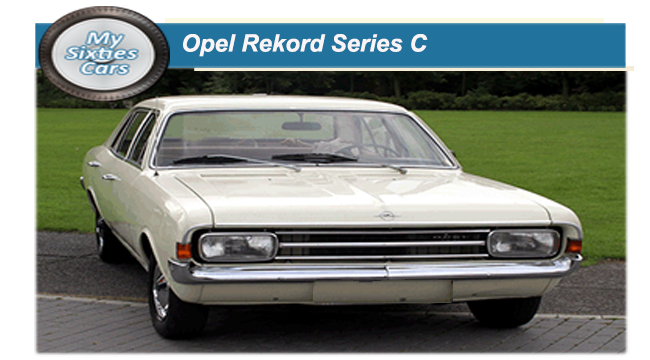 Opel introduced the Rekord C Series in August 1966 as a replacement for the Series B that they suprisingly discontinued after a very short and succesful production run that continued for less than a year.
Opel introduced the Rekord C Series in August 1966 as a replacement for the Series B that they suprisingly discontinued after a very short and succesful production run that continued for less than a year.
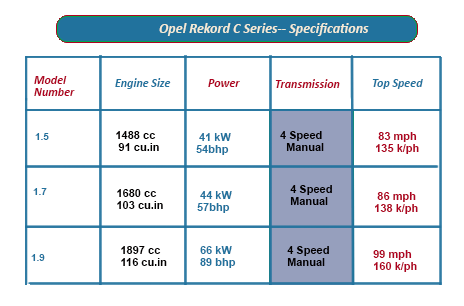 ce between the Opel Rekord Series C was far from staggering, with slightly larger and entirely new bodywork and round body and sitting on more or less the same chassis and with the same powertrains.
ce between the Opel Rekord Series C was far from staggering, with slightly larger and entirely new bodywork and round body and sitting on more or less the same chassis and with the same powertrains.
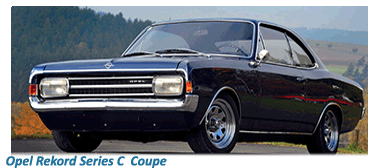 The European motoring press of the era, who had wasted little effort in covering up the fact that the Rekord Series B bore a less than passing resemblance to Vauxhall's ( Opel's sister company at GM ) Viva HB series, this time they were positively emphatic.
As was the case with the Viva HB, the Rekord C’s strongest design characteristic was the "hip-curve" that stood out on the car’s lower window-line just ahead of its C-pillar, in the curvy shape of a Coca-Cola bottle.
As was their policy Opel offered a wide choice of body shapes with the Rekord, with this time a convertible being made available, based on the coupe's “pillarless” design.
Because demand was expected to be low, production was farmed out to Karl Deutsch GmbH of Cologne, at that time the leading company in West Germany for sub-contracted cabriolet production.
The European motoring press of the era, who had wasted little effort in covering up the fact that the Rekord Series B bore a less than passing resemblance to Vauxhall's ( Opel's sister company at GM ) Viva HB series, this time they were positively emphatic.
As was the case with the Viva HB, the Rekord C’s strongest design characteristic was the "hip-curve" that stood out on the car’s lower window-line just ahead of its C-pillar, in the curvy shape of a Coca-Cola bottle.
As was their policy Opel offered a wide choice of body shapes with the Rekord, with this time a convertible being made available, based on the coupe's “pillarless” design.
Because demand was expected to be low, production was farmed out to Karl Deutsch GmbH of Cologne, at that time the leading company in West Germany for sub-contracted cabriolet production.
![]()
The Series c came once again with the same configuration of engines available on the Series B, the 1498cc “1500” engine, although this time with its carburettor initially being supplied by Zenith, latterly by Solex, the leading French manufacturer.
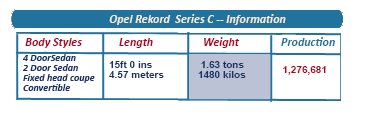 The four-cylinder 1698 cc “1700”, first fitted in the Rekord B, was initially backed up by a Carter carburettor, replaced by a Solex at the end of the first year's production.
The four-cylinder 1698 cc “1700”, first fitted in the Rekord B, was initially backed up by a Carter carburettor, replaced by a Solex at the end of the first year's production.
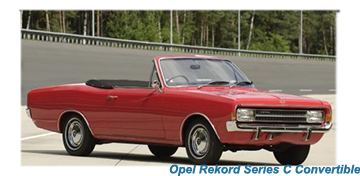 The "1700" version rapidly proved to be the best-selling engine of the three choices available during the C’s lengthy production run.
The Rekord C range increased in December 1966 with the option of an entirely new six-cylinder engine, the "1900 S" a four-cylinder water-cooled 1897 cc unit.
All three powertrains could come fitted with either a three-speed or four-speed transmission, with the four-speed becoming standard from 1970.
Despite expectations to the contrary, the 6-cylinder engined Rekord C sold only in small numbers, and in August 1968, two years after launch, found itself removed from the options list.
The "1700" version rapidly proved to be the best-selling engine of the three choices available during the C’s lengthy production run.
The Rekord C range increased in December 1966 with the option of an entirely new six-cylinder engine, the "1900 S" a four-cylinder water-cooled 1897 cc unit.
All three powertrains could come fitted with either a three-speed or four-speed transmission, with the four-speed becoming standard from 1970.
Despite expectations to the contrary, the 6-cylinder engined Rekord C sold only in small numbers, and in August 1968, two years after launch, found itself removed from the options list.
![]()
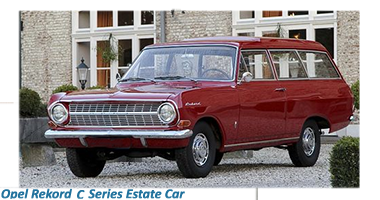 e was only available in either sedan or coupé format and was set apart from the Rekord by its vinyl top. Barely setting the heather on fire, the Opel Commodore sold just over 150,000 models during its four-year production run.
The Rekord C remained in production for close to five years, selling more than one million and a quarter during that period, until replaced by the Series D early in 1972.
e was only available in either sedan or coupé format and was set apart from the Rekord by its vinyl top. Barely setting the heather on fire, the Opel Commodore sold just over 150,000 models during its four-year production run.
The Rekord C remained in production for close to five years, selling more than one million and a quarter during that period, until replaced by the Series D early in 1972.







